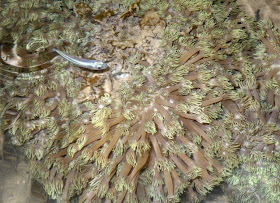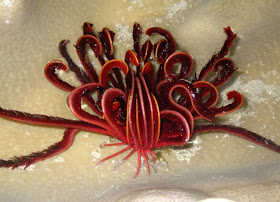Thankfully, we are fortunately blessed with good weather, so much that we can see constellations of stars on one end of the sky!

Wow, is this the stars that I was describing to you from the sky above Hantu? No no no... The "starry" spots on the black background belongs to...

This marine flatworm that looks almost totally black from the top! It is something totally new to me as I've never seen such a flatworm before.

What is more fascinating of these "starry" spots on the surface of this seemingly black boring plain flatworm is that the spots come in an assortment of different colours, i.e. purple, yellow, green, blue, pink, brown and the list of colours goes on! I only found this out when I zoomed in photographs taken of this critter. Isn't God's creation wonderful, down to the details?

Talking about being colourful, the reefs at Hantu are filled with colours, with different types of marine sponges thriving together. Here we can see three species of sponges with tiny brittlestars living within the brown one.

During the predawn, the animals are usually having a party at the reefs. Fishes are swimming everywhere. Even when I was taking a photograph of this anemone coral (Goniopora sp.), a Tropical silverside (Atherinomorus duodecimalis) also swam past.

There are many different hard corals that one can find at Hantu's reef including the Acropora coral (Acropora sp.).

Even within or between the coral colony, there are living creatures like the tiny coral scallops!

There are also other coral species with coral scallops in between. This coral is probably the Carnation corals (Pectinia sp.).

I am not too sure what is this greenish branching-looking coral colony but it probably is the Branching pore coral (Porites sp.).

This type of disk coral is particularly pretty as compared to the more commonly found ones and this is probably the Encrusting disk coral (Turbinaria sp.).

Hantu is a nice place to spot mushroom corals like this Mole mushroom hard coral (Polyphyllia talpina).

Another longish mushroom coral will be this Tongue mushroom hard coral (Herpolitha sp.). Strangely, I didn't encounter any of the Circular mushroom hard coral but it was a relief that the others did saw them around the reef.
So much for the corals! Now the reef associates :-)
Today's there are really many red feather stars! Every few steps, we will encounter them.

Geraldine even found one above the leathery soft coral!

Despite the abundance of the red feather star, I also saw one black feather star.

And another in beige and brown colour.

This creature is no feather star and is much bigger than the feather star (around 30cm in diameter). This scary looking creature is a rare sea anemone called the Haekel's anemone (Actinostephanus haekeli).

The tentacles are studded with bumps. In fact, Ria saw that one of its tentacle was position at the mouth of the anemone. What is happening? Is it feeding on its own tentacle.... it sure looks evil. :P

Another anemone, but a much way smaller one, will be this Shy glass peacock anemone that I have took notice for the first time too. This peacock is easily overlooked because it is near transparent.

While I was slowly threading within the thickly covered reef, I spotted this Long-spined black sea urchin (Diadema sp.) which I have not seen for a while already.
Though the spines looks real dangerous, it actually only feeds on seaweed, grazing these from dead corals or rubble areas. It may also trap tiny suspended food particles with its long spines, transferring these to the mouth with tube feet.

Another echinoderm that can be found at Southern shore reefs will be this Stonefish sea cucumber (Actinopyga lecanora). The common name is as such because it looks like a smooth stone when disturbed; bloating up into a rounded, smooth shape and retracting its tube feet. However, when relaxed, the animal can be quite long and thin.

Geraldine later spotted this pretty spider conch (Lambis lambis). At first, she wasn't sure what it was since it is usually well camouflaged from the top. Only when you turn it around, you can see the pretty pinkish and white shell interior.

Ah huh! I caught this Blue swimming crab (Thalamita sp.) red handed eating on this venus clam. Janette has recently also started a blog and shared with us her two finds of the mosaic crab feeding (with literally its red pincers aka "red handed") on the common sea star and a sea urchin! It is called Nature calls. :-)

There were a couple of cool fishy finds like this tiny Longspined scorpionfish (Paracentropogon longispinis) which is small and well camouflaged. Even Geraldine also didn't see it when I pointed it to her. She thought I was showing her seaweed.

A much larger fish that I also found will be this one that I don't know what is it. But the stripes on its fins are very beautiful!
The remaining time of the Hantu exploration was spent within the lagoon itself.

And I spotted yet another mushroom coral, this one is the Sunflower mushroom hard coral (Heliofungia actiniformis). Their thick cylindrical tentacles looks like thick noodles. Haha!

Surprisingly, I saw this Thorny sea cucumber (Colochirus quadrangularis) which is rarely sighted at the Southern shores, though very common in the north.

There are many carpet anemones around the lagoon and this particular Giant carpet anemone (Stichodactyla gigantea) has a stranded False clown anemonefish (Amphiprion ocellaris).We later gently help the anemonefish back into the anemone with seawater.
And just before we had to leave, was a climax of the day.

I found this Spotted-tail frogfish (Lophiocharon trisignatus) at the tape seagrass! Often well sought after with divers, they can be also found at our intertidal shores of Singapore! And I particular like this frogfish in really cool lime green colour.

If you look closely, the frogfish has a bait or a lure at the top of the head to attract prey within striking distance. It is capable of 'sucking' small fishes into its huge mouth simply by opening it.
Wow, that was a great Hantu predawn trip exploring one of the best accessible reefs in Singapore. Great that we avoided the thunderstorm again..! :-) Can't wait to return to Hantu again.
You have a wonderful post today. You are absolutely right about God's creation is off the charts! I thank you for the reminder!
ReplyDeleteI've never seen that fish before!! COOL!
ReplyDeletewow i love how u made the comparison with the spots on the flatworm and the stars in the sky! now i'll never look at them the same way again =)
ReplyDelete